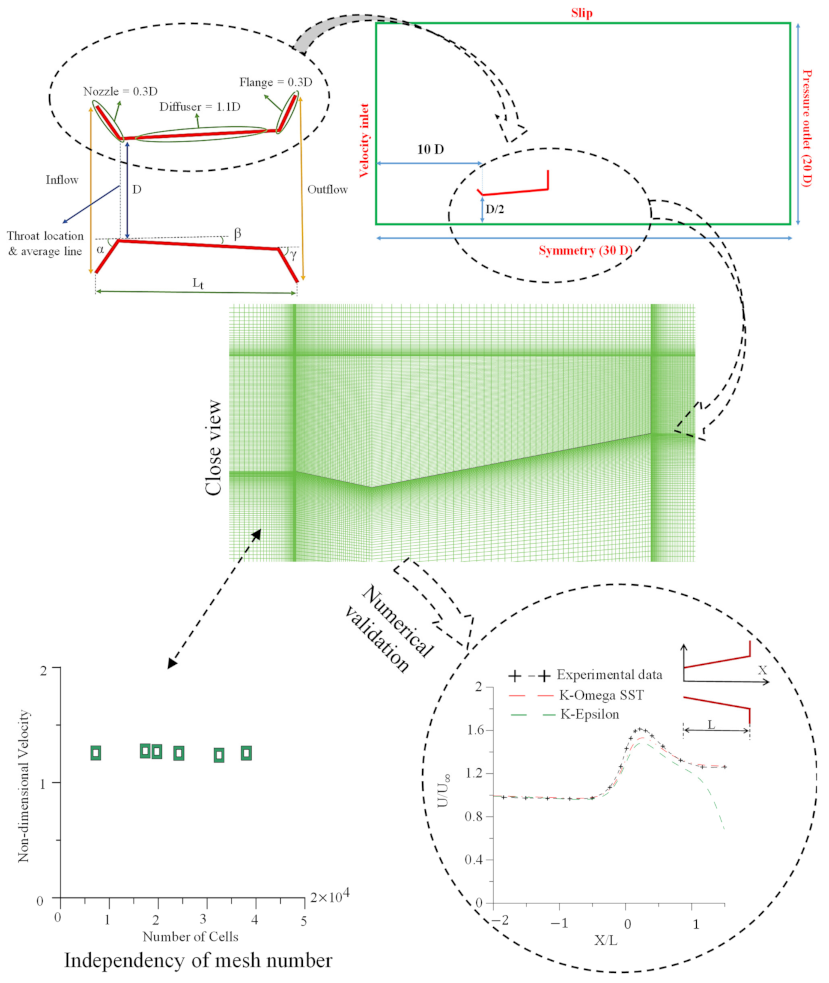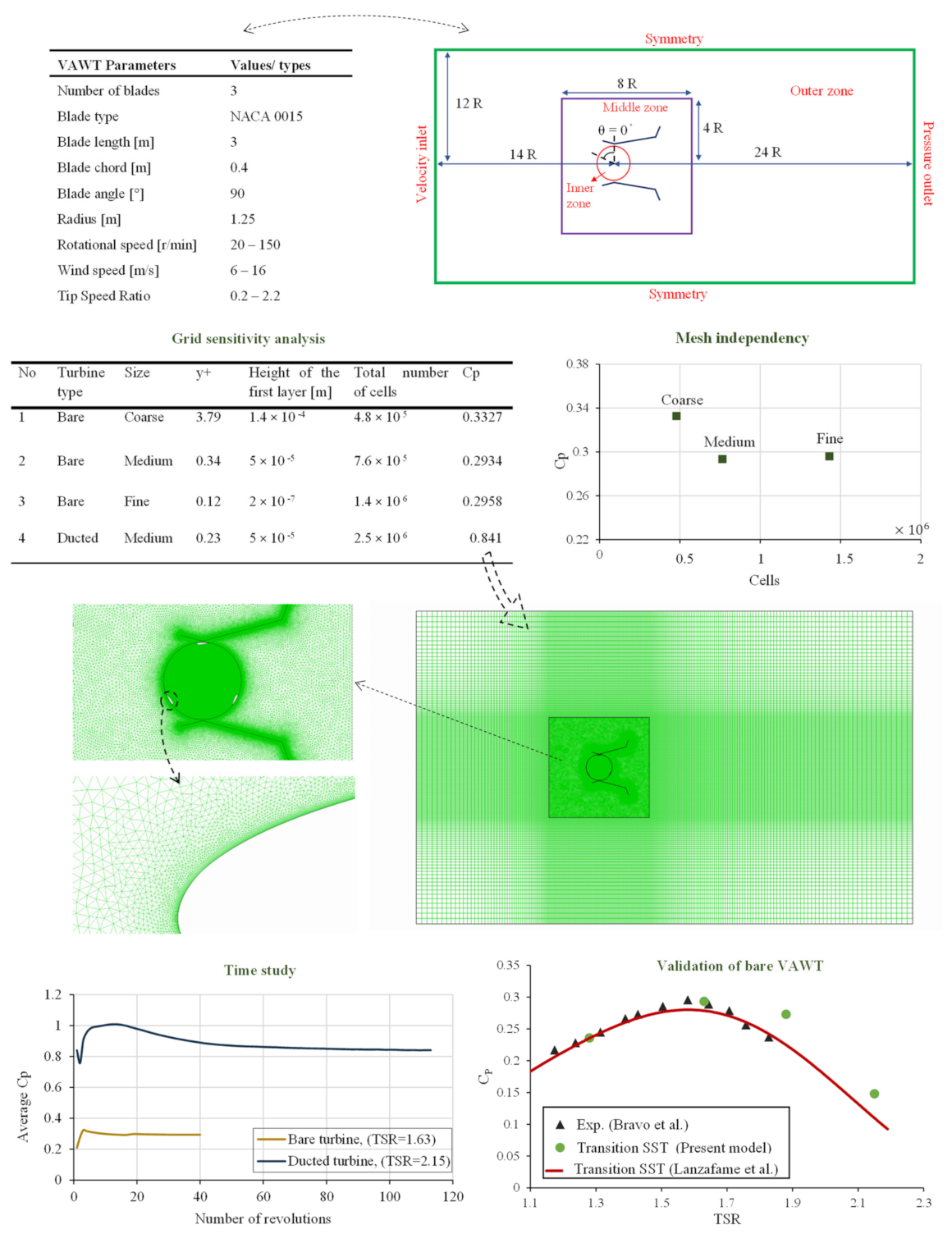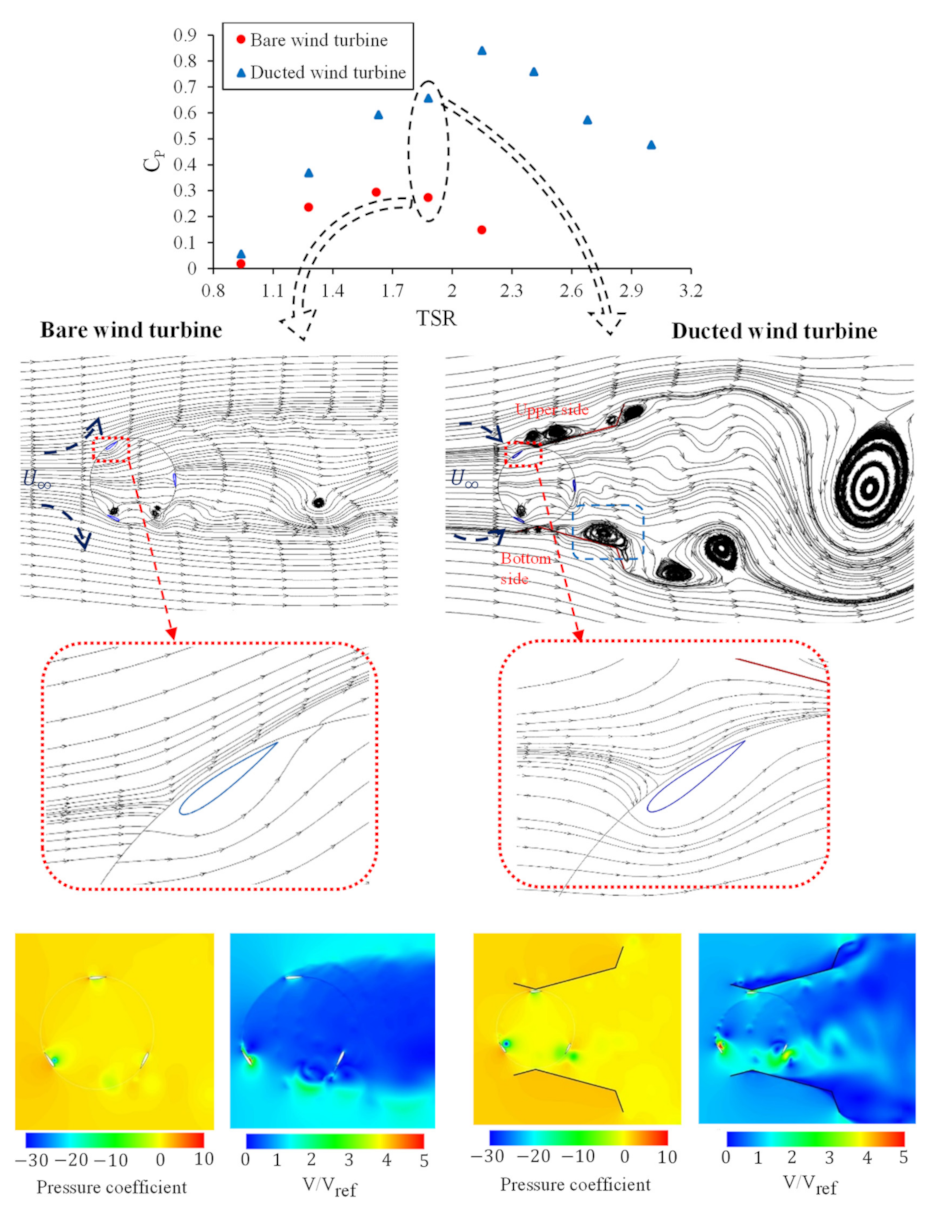Power Enhancement of a Vertical Axis Wind Turbine Equipped with an Improved Duct
Abstract
:1. Introduction
2. Geometry and Numerical Approach of Duct Study
3. Optimization
3.1. Geometry Creation
3.2. Blocking
3.3. Structured Grid
3.4. Numerical Simulation
3.5. Kriging Method
3.6. Maximum Throat Velocity
3.7. Optimized Duct
4. Ducted Wind Turbine: Numerical Approach
5. Ducted Wind Turbine vs. Bare Wind Turbine
6. Conclusions
Author Contributions
Funding
Acknowledgments
Conflicts of Interest
References
- Anon, D. Costa Head Experimental Wind Turbine; Orkney Sustainable Energy Ltd.: Orkney, UK, 2010; Available online: http://www.orkneywind.co.uk/costa.html (accessed on 12 July 2021).
- Lilley, G.; Rainbird, W. A Preliminary Report on the Design and Performance of Ducted Windmills. 1956. Available online: http://dspace.lib.cranfield.ac.uk/handle/1826/7971 (accessed on 12 July 2021).
- Saleem, A.; Kim, M.-H. Aerodynamic analysis of an airborne wind turbine with three different aerofoil-based buoyant shells using steady RANS simulations. Energy Convers. Manag. 2018, 177, 233–248. [Google Scholar] [CrossRef]
- Bontempo, R.; Manna, M. On the potential of the ideal diffuser augmented wind turbine: An investigation by means of a momentum theory approach and of a free-wake ring-vortex actuator disk model. Energy Convers. Manag. 2020, 213, 112794. [Google Scholar] [CrossRef]
- Saleem, A.; Kim, M.-H. Effect of rotor tip clearance on the aerodynamic performance of an aerofoil-based ducted wind turbine. Energy Convers. Manag. 2019, 201, 112186. [Google Scholar] [CrossRef]
- Avallone, F.; Ragni, D.; Casalino, D. On the effect of the tip-clearance ratio on the aeroacoustics of a diffuser-augmented wind turbine. Renew. Energy 2020, 152, 1317–1327. [Google Scholar] [CrossRef]
- Saleem, A.; Kim, M.-H. Performance of buoyant shell horizontal axis wind turbine under fluctuating yaw angles. Energy 2019, 169, 79–91. [Google Scholar] [CrossRef]
- Suri, D.; Mukherjee, A.; Nayak, R.; Radhakrishnan, J.; Kwee, N.Y. Lighter-Than-Air Wind Energy Systems: Stability Analysis. In Proceedings of the International Conference on Mechanical Materials and Renewable Energy 2019, Rangpo, India, 6–7 December 2019. [Google Scholar]
- Dilimulati, A.; Stathopoulos, T.; Paraschivoiu, M. Wind turbine designs for urban applications: A case study of shrouded diffuser casing for turbines. J. Wind Eng. Ind. Aerodyn. 2018, 175, 179–192. [Google Scholar] [CrossRef] [Green Version]
- Bontempo, R.; Manna, M. Diffuser augmented wind turbines: Review and assessment of theoretical models. Appl. Energy 2020, 280, 115867. [Google Scholar] [CrossRef]
- Van Bussel, G.J. The science of making more torque from wind: Diffuser experiments and theory revisited. J. Phys. Conf. Ser. 2007, 75, 012010. [Google Scholar] [CrossRef]
- Bontempo, R.; Manna, M. Effects of the duct thrust on the performance of ducted wind turbines. Energy 2016, 99, 274–287. [Google Scholar] [CrossRef]
- Igra, O. Research and development for shrouded wind turbines. Energy Convers. Manag. 1981, 21, 13–48. [Google Scholar] [CrossRef]
- Agha, A.; Chaudhry, H.N.; Wang, F. Diffuser augmented wind turbine (DAWT) technologies: A review. Int. J. Renew. Energy Res. (IJRER) 2018, 8, 1369–1385. [Google Scholar]
- Ohya, Y.; Karasudani, T. A shrouded wind turbine generating high output power with wind-lens technology. Energies 2010, 3, 634–649. [Google Scholar] [CrossRef] [Green Version]
- Heikal, H.A.; Abu-Elyazeed, O.S.; Nawar, M.A.; Attai, Y.A.; Mohamed, M.M. On the actual power coefficient by theoretical developing of the diffuser flange of wind-lens turbine. Renew. Energy 2018, 125, 295–305. [Google Scholar] [CrossRef]
- Rochman, M.N.; Nasution, A.; Nugroho, G. CFD Studies on the Flanged Diffuser Augmented Wind Turbine with Optimized Curvature Wall. In ICoSI 2014; Springer: Singapore, 2017; pp. 347–355. [Google Scholar]
- Ranjbar, M.H.; Nasrazadani, S.A.; Gharali, K. Optimization of a Flanged DAWT Using a CFD Actuator Disc Method. In International Conference on Applied Mathematics, Modeling and Computational Science; Springer: Waterloo, ON, Canada, 2017; pp. 219–228. [Google Scholar]
- El-Zahaby, A.M.; Kabeel, A.; Elsayed, S.; Obiaa, M. CFD analysis of flow fields for shrouded wind turbine’s diffuser model with different flange angles. Alex. Eng. J. 2017, 56, 171–179. [Google Scholar] [CrossRef] [Green Version]
- Kosasih, B.; Tondelli, A. Experimental study of shrouded micro-wind turbine. Procedia Eng. 2012, 49, 92–98. [Google Scholar] [CrossRef] [Green Version]
- Wang, X.; Wong, K.; Chong, W.; Ng, J.; Xiang, X.; Wang, C. Experimental investigation of a diffuser-integrated vertical axis wind turbine. In IOP Conference Series: Earth and Environmental Science; IOP: Bangkok, Thailand, 2020. [Google Scholar]
- Watanabe, K.; Takahashi, S.; Ohya, Y. Application of a diffuser structure to vertical-axis wind turbines. Energies 2016, 9, 406. [Google Scholar] [CrossRef] [Green Version]
- Ghazalla, R.; Mohamed, M.; Hafiz, A. Synergistic analysis of a Darrieus wind turbine using computational fluid dynamics. Energy 2019, 189, 116214. [Google Scholar] [CrossRef]
- Zanforlin, S.; Buzzi, F.; Francesconi, M. Performance Analysis of Hydrofoil Shaped and Bi-Directional Diffusers for Cross Flow Tidal Turbines in Single and Double-Rotor Configurations. Energies 2019, 12, 272. [Google Scholar] [CrossRef] [Green Version]
- Hashem, I.; Mohamed, M. Aerodynamic performance enhancements of H-rotor Darrieus wind turbine. Energy 2018, 142, 531–545. [Google Scholar] [CrossRef]
- Dessoky, A.; Bangga, G.; Lutz, T.; Krämer, E. Aerodynamic and aeroacoustic performance assessment of H-rotor darrieus VAWT equipped with wind-lens technology. Energy 2019, 175, 76–97. [Google Scholar] [CrossRef]
- Zanforlin, S.; Letizia, S. Effects of upstream buildings on the performance of a synergistic roof-and-diffuser augmentation system for cross flow wind turbines. J. Wind Eng. Ind. Aerodyn. 2019, 184, 329–341. [Google Scholar] [CrossRef]
- Gharali, K.; Johnson, D.A. Dynamic stall simulation of a pitching airfoil under unsteady freestream velocity. J. Fluids Struct. 2013, 42, 228–244. [Google Scholar] [CrossRef]
- Gharali, K.; Johnson, D.A.; Lam, V.; Gu, M. A 2D blade element study of a wind turbine rotor under yaw loads. Wind Eng. 2015, 39, 557–567. [Google Scholar] [CrossRef]
- Gharali, K.; Gharaei, E.; Soltani, M.; Raahemifar, K. Reduced frequency effects on combined oscillations, angle of attack and free stream oscillations, for a wind turbine blade element. Renew. Energy 2018, 115, 252–259. [Google Scholar] [CrossRef]
- Bakhtiari, E.; Gharali, K.; Chini, S.F. Corrigendum to “Super-hydrophobicity effects on performance of a dynamic wind turbine blade element under yaw loads”. Renew. Energy 2019, 140, 539–551, Erratum in: 2020, 147, 2528. [Google Scholar] [CrossRef]
- Hamada, K.; Smith, T.; Durrani, N.; Qin, N.; Howell, R. Unsteady flow simulation and dynamic stall around vertical axis wind turbine blades. In Proceedings of the 46th AIAA Aerospace Sciences Meeting and Exhibit, Reno, NV, USA, 7–10 January 2008; p. 1319. [Google Scholar]
- Bangga, G.; Hutomo, G.; Wiranegara, R.; Sasongko, H. Numerical study on a single bladed vertical axis wind turbine under dynamic stall. J. Mech. Sci. Technol. 2017, 31, 261–267. [Google Scholar] [CrossRef]
- Jamieson, P.M. Beating betz: Energy extraction limits in a constrained flow field. J. Sol. Energy Eng. 2009, 131. [Google Scholar] [CrossRef]
- Patankar, S.V. Numerical Heat Transfer and Fluid Flow (Book); Hemisphere Publishing Corp.: Washington, DC, USA, 1980; 210p. [Google Scholar]
- Ohya, Y.; Karasudani, T.; Sakurai, A.; Abe, K.-I.; Inoue, M. Development of a shrouded wind turbine with a flanged diffuser. J. Wind Eng. Ind. Aerodyn. 2008, 96, 524–539. [Google Scholar] [CrossRef]
- Bontempo, R.; Manna, M. Performance analysis of open and ducted wind turbines. Appl. Energy 2014, 136, 405–416. [Google Scholar] [CrossRef]
- Khamlaj, T.A.; Rumpfkeil, M.P. Analysis and optimization of ducted wind turbines. Energy 2018, 162, 1234–1252. [Google Scholar] [CrossRef]
- Abe, K.-i.; Ohya, Y. An investigation of flow fields around flanged diffusers using CFD. J. Wind Eng. Ind. Aerodyn. 2004, 92, 315–330. [Google Scholar] [CrossRef]
- Box, G.; Wilson, K. On the Experimental Attainment of Optimum Conditions. J. R. Stat. Society. Ser. B (Methodol.) 1951, 13, 1–45. [Google Scholar] [CrossRef]
- Cavazzuti, M. Optimization Methods: From Theory to Design Scientific and Technological Aspects in Mechanics; Springer Science & Business Media: Berlin, Germany, 2012. [Google Scholar]
- Dimitrov, N.; Kelly, M.C.; Vignaroli, A.; Berg, J. From wind to loads: Wind turbine site-specific load estimation with surrogate models trained on high-fidelity load databases. Wind Energy Sci. 2018, 3, 767–790. [Google Scholar] [CrossRef] [Green Version]
- Kumar, P.M.; Seo, J.; Seok, W.; Rhee, S.H.; Samad, A. Multi-fidelity optimization of blade thickness parameters for a horizontal axis tidal stream turbine. Renew. Energy 2019, 135, 277–287. [Google Scholar] [CrossRef]
- Slot, R.M.; Sørensen, J.D.; Sudret, B.; Svenningsen, L.; Thøgersen, M.L. Surrogate model uncertainty in wind turbine reliability assessment. Renew. Energy 2020, 151, 1150–1162. [Google Scholar] [CrossRef] [Green Version]
- Ranjbar, M.H.; Nasrazadani, S.A.; Zanganeh Kia, H.; Gharali, K. Reaching the betz limit experimentally and numerically. Energy Equip. Syst. 2019, 7, 271–278. [Google Scholar]
- Ranjbar, M.H.; Zanganeh Kia, H.; Nasrazadani, S.A.; Gharali, K.; Nathwani, J. Experimental and numerical investigations of actuator disks for wind turbines. Energy Sci. Eng. 2020, 8, 2371–2386. [Google Scholar] [CrossRef] [Green Version]
- Bravo, R.; Tullis, S.; Ziada, S. Performance testing of a small vertical-axis wind turbine. In Proceedings of the 21st Canadian Congress of Applied Mechanics, Toronto, ON, Canada, 3–7 June 2007. [Google Scholar]
- Hansen, M.O.L.; Sørensen, N.N.; Flay, R. Effect of placing a diffuser around a wind turbine. Wind Energy Int. J. Prog. Appl. Wind Power Convers. Technol. 2000, 3, 207–213. [Google Scholar] [CrossRef]
- Cresswell, N.; Ingram, G.; Dominy, R. The impact of diffuser augmentation on a tidal stream turbine. Ocean Eng. 2015, 108, 155–163. [Google Scholar] [CrossRef] [Green Version]
- Kwong, A.H.; Dowling, A.P. Active boundary-layer control in diffusers. AIAA J. 1994, 32, 2409–2414. [Google Scholar] [CrossRef]
- Lanzafame, R.; Mauro, S.; Messina, M. 2D CFD modeling of H-Darrieus wind turbines using a transition turbulence model. Energy Procedia 2014, 45, 131–140. [Google Scholar] [CrossRef] [Green Version]
- Paraschivoiu, I. Wind Turbine Design: With Emphasis on Darrieus Concept; Polytechnique: Montreal, QC, Canada, 2002. [Google Scholar]





Publisher’s Note: MDPI stays neutral with regard to jurisdictional claims in published maps and institutional affiliations. |
© 2021 by the authors. Licensee MDPI, Basel, Switzerland. This article is an open access article distributed under the terms and conditions of the Creative Commons Attribution (CC BY) license (https://creativecommons.org/licenses/by/4.0/).
Share and Cite
Ranjbar, M.H.; Rafiei, B.; Nasrazadani, S.A.; Gharali, K.; Soltani, M.; Al-Haq, A.; Nathwani, J. Power Enhancement of a Vertical Axis Wind Turbine Equipped with an Improved Duct. Energies 2021, 14, 5780. https://doi.org/10.3390/en14185780
Ranjbar MH, Rafiei B, Nasrazadani SA, Gharali K, Soltani M, Al-Haq A, Nathwani J. Power Enhancement of a Vertical Axis Wind Turbine Equipped with an Improved Duct. Energies. 2021; 14(18):5780. https://doi.org/10.3390/en14185780
Chicago/Turabian StyleRanjbar, Mohammad Hassan, Behnam Rafiei, Seyyed Abolfazl Nasrazadani, Kobra Gharali, Madjid Soltani, Armughan Al-Haq, and Jatin Nathwani. 2021. "Power Enhancement of a Vertical Axis Wind Turbine Equipped with an Improved Duct" Energies 14, no. 18: 5780. https://doi.org/10.3390/en14185780
APA StyleRanjbar, M. H., Rafiei, B., Nasrazadani, S. A., Gharali, K., Soltani, M., Al-Haq, A., & Nathwani, J. (2021). Power Enhancement of a Vertical Axis Wind Turbine Equipped with an Improved Duct. Energies, 14(18), 5780. https://doi.org/10.3390/en14185780






